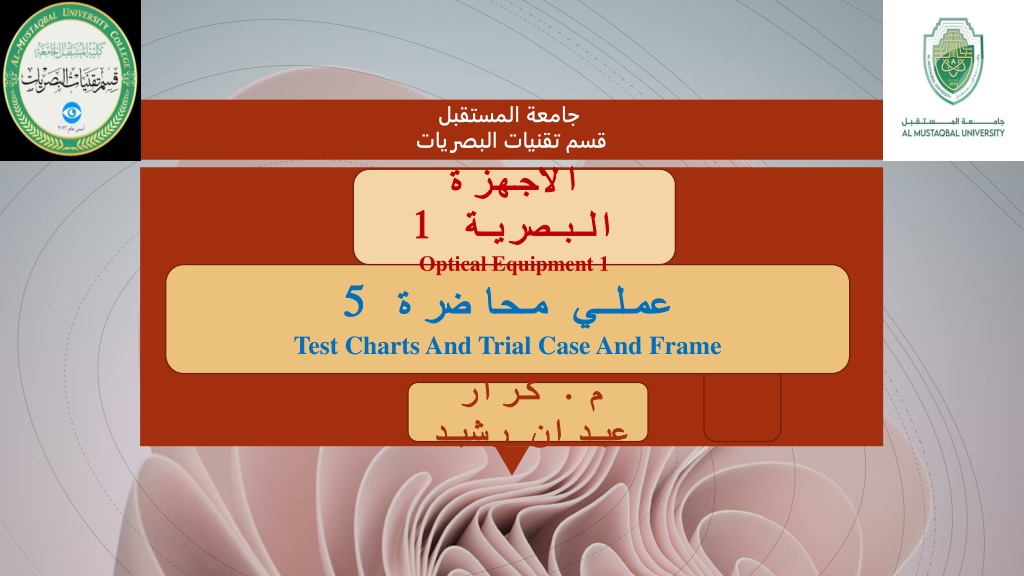

0 likes | 6 Views
Visual acuity is the eye's ability to discern single targets clearly on the retina, crucial for vision assessment. Various eye charts like Snellen, Landolt C, Bailey-Lovie, and more are used to measure visual acuity for different purposes. This guide explains the principles, types of charts, testing procedures, and common abbreviations used in clinical practice.

E N D
لبقتسملا ةعماج تايرصبلا تاينقت مسق ةزهجلاا ةزهجلاا ةيرصبلا ةيرصبلا 1 1 Optical Equipment 1 ةرضاحم ةرضاحم Test Charts And Trial Case And Frame رارك رارك ديشر ناديع ديشر ناديع 5 5 يلمع يلمع . . م م
2 Introduction
Visual acuity: The ability of the eye to distinguish single targets and form a clear image of sufficient size on the retina, specifically on the macula. Visual Acuity It depends on two factors: 1) The size of the object of which an image is formed on the retina. 2) The distance of the body from the eye 3
A Snellen chart is an eye chart that can be used to measure visual or measures a person’s vision by how well they can Snellen chart read and see detail. Its name comes from Dr. Hermann Snellen, who invented the eye chart in 1862. 4
E chart: used to measure a patient's visual acuity. Uses : This chart is useful for patients E chart who are unable to read the Latin alphabet – for example, very young children. It is also used in countries where people do not use the alphabet in their native language – for example, in China. 5
The Landolt C also known as a Landolt ring, Landolt broken ring, or Japanese vision test, is an optotype: a standardized C chart symbol used for testing vision. It was developed by the Swiss-born ophthalmologist Edmund Landolt. 6
The Bailey-Lovie chart determines the distance of visual acuity at normal and low contrast. The lower contrast version is also available. Bailey Lovie Chart 7
The ETDRS is a test used to measure the visual acuity of patients who suffer from low vision, that is to say, with vision below the desired level and it takes its name from the study for which it was designed: EtdrsChart Early Treatment Diabetic Retinopathy Study. 8
The Jaeger chart is an eye chart used in testing near vision acuity. Jaeger Chart 9
LEA Symbols Chart: This chart was designed for visual acuity screening in children to eliminate the problems of language barriers. LEA Symbols Chart 10
The Freiburg Visual Acuity test is an automated procedure for self-administered measurement of visual acuity. Landolt-Cs are presented on a monitor FrACTChart 11
1. Position the patient sitting 6m from the chart. Note that projecting the chart on a mirror can be a useful way to simulate the 6m testing distance Snellen Chart in shorter clinical lanes. Procedure 2. Ensure that the room and Snellen chart are adequately illuminated. 3. The patient may wear his/her current corrective lenses to assess for corrected visual acuity. 12
4. In the absence of corrective lenses, a pinhole may be used, which often resolves the refractive error. This is done by assessing visual acuity while Snellen Chart looking through a pinhole. 5. Test the eyes one at a time, beginning with the Procedure worse eye while covering the good eye. 6. Ask the patient to begin reading letters from the top. 7. The smallest line read represents the visual acuity. 13
8. Patients unable to read the large E on the chart , when wearing the best corrective lens have a visual acuity measuring less than 6/60, which is termed "legally blind" in the United States. 9. For patients unable to see the eye chart, check if they can count fingers (CF vision), see hand movements (HM vision), or perceive the light from a flashlight (LP vision). If the patient fails to identify the light, record this as no light perception (NLP). 10. Repeat the procedure to measurement the opposite eye. Snellen Chart Procedure 14
The following abbreviations are commonly used in the reporting of visual acuity measurements. OD: Right eye OS: Left eye OU: Both eyes VA: Visual acuity DVA: Distance visual acuity NVA: Near visual acuity Understanding Abbreviations in Clinical Practice 15
PH: Pinhole CF: Counting fingers HM: Hand motion LP: Light perception NLP: No light perception Understanding Abbreviations in Clinical Practice 16